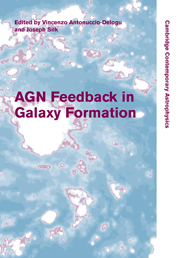Book contents
- Frontmatter
- Contents
- List of contributors
- Preface
- The organising committees
- Part I AGNs, starbursts and galaxy evolution
- Part II Co-evolution of black holes and galaxies
- 5 The symbiosis between galaxies and SMBHs
- 6 On the origin of halo assembly bias
- 7 AGN, downsizing and galaxy bimodality
- Part III Outflows and radio galaxies
- Part IV Models and numerical simulations: methods and results
- Index
7 - AGN, downsizing and galaxy bimodality
from Part II - Co-evolution of black holes and galaxies
Published online by Cambridge University Press: 10 November 2010
- Frontmatter
- Contents
- List of contributors
- Preface
- The organising committees
- Part I AGNs, starbursts and galaxy evolution
- Part II Co-evolution of black holes and galaxies
- 5 The symbiosis between galaxies and SMBHs
- 6 On the origin of halo assembly bias
- 7 AGN, downsizing and galaxy bimodality
- Part III Outflows and radio galaxies
- Part IV Models and numerical simulations: methods and results
- Index
Summary
Introduction
Only by incorporating various forms of feedback can theories of galaxy formation reproduce the present-day luminosity function of galaxies. It has also been argued that such feedback processes might explain the counterintuitive behaviour of ‘downsizing’ witnessed since redshifts z ≈ 1 − 2. To examine this question, observations spanning 0.4 < z < 1.4 from the DEEP2/Palomar survey (Bundy et al. 2006) are compared with a suite of equivalent mock observations derived from the Millennium Simulation, populated with galaxies using the Galform code (Bower et al. 2006).
Hierarchical assembly
The mock galaxy samples are generated from the population of dark matter halos in the Millennium Simulation (Springel et al. 2005). This simulation consists of approximately 10 billion dark matter particles each of mass 8.6 × 108h−1M⊙ evolving in a cubic volume of side 500h−1 Mpc, assuming a ∧CDM cosmology.
Dark matter halo merger trees are found from this 4-volume using the methods described by Harker et al. (2006). The lowest mass halos contained in these trees, of which there are about 20 million, consist of 20 particles corresponding to a total mass of 5 × 109h−1M⊙. Such halos could contain at most 9 × 108h−1M⊙ of baryonic material, which is well below the lower limit of the stellar mass functions to be considered in this work. Therefore we do not expect the resolution of the Millennium Simulation to affect our results.
- Type
- Chapter
- Information
- AGN Feedback in Galaxy Formation , pp. 52 - 60Publisher: Cambridge University PressPrint publication year: 2010

